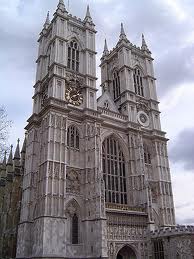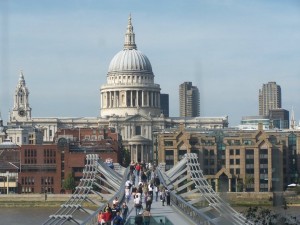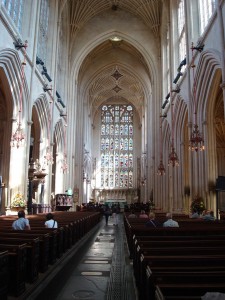September 20th, 2010 · 2 Comments
Most of you have been writing about the secular nature of churches in England, how they don’t really seem like a spiritual community, and how it is a bit disturbing that all of them come with cafes and gift shops. While I agree with these thoughts, I don’t think that it is necessarily all bad, and I think that we need to consider that we are not seeing the entire picture.
I think that the secularism of the Anglican Church particularly stands out against our visits to the Mandir and the mosque. At these places of worship, people go to pray every day and there are spiritual ceremonies every day as well. They each have schools, child care centers, and service projects that reach out to the community. I can see where we might wonder why we are not seeing the Anglican Church step up to its role as a spiritual and community leader, but remember that we discussed in our first ever class meeting how in these minority communities, religion is very much one and the same with culture, especially in Islam. The difficulties they have assimilating into English culture are due in large part to religion. Religious teachings and traditions have become well ingrained cultural traditions. Anglicanism is a relatively new religion in comparison with Hindu and Islam, and does not play the role of being one and the same with culture like it does in the other communities. And when you are the majority community racially, religiously, politically etc…it doesn’t need to be.

the Mandir, courtesy of it’s website mandir.org
The second point I wanted to make in this post is that Westminster Abbey and St. Paul’s do remember their function as places of worship. I was on the Westminster Abbey tour with the science group. We were there at noon, and at that time an announcement came on that called for a moment of silence. John reminded us that we were in a church, not a museum, and I noticed that nearly everyone visiting the Abbey at that time, tourists included, was respectful of this moment. I also attended Evensong at St. Paul’s and thought that it was a beautiful and moving experience. I think that they balance their two roles as best as they can, and hey, if my church had a café, I would use it. Speaking of places of worship that balance spirituality and tourism, look at Vatican City. No one can argue that this is not a deeply meaningful and spiritual place; Catholics journey from miles around to hear the Pope speak on Christmas, or at any other time of the year really, but it is also a huge attraction, complete with guided tours through St. Peters and rampant pick pocketing.

photo credit: Google Images

photo credit: Google Images. All of these buildings were too big and beautiful for me to take a good picture of them myself.
Finally, the fact remains that we have not been to any small Anglican parishes in specific residential neighborhoods of London. I’m sure that there are religious Anglicans in London who do go to church every Sunday and whose churches run community service projects and functions, but, similar to your local church at home, which also attracts no visitors, these churches probably don’t have history such as the Battle of Hastings and the Great Fire of London surrounding them. We definitely are not seeing the whole picture here, which is why I cannot join in lamenting and expressing disappointment in places like Westminster Abbey or St. Paul’s, or the Anglican Church in general.
Tags: 2010 Kaitlin
September 15th, 2010 · 7 Comments

After visiting several religious sites, including St. Paul’s Cathedral, Westminster Abbey, the Shri Swaminarayan Mandir, and the East London Mosque, I have noticed two prevailing influences on places of religious worship in London: government involvement and tourism. Given England’s history of combining church and state, and the level of tourism in London, it is no wonder that one finds these influences, to varying degrees, in places of religious worship around the city. What is debatable is what effect tourism and government have on religious life and the worship within each of these buildings. In my opinion, churches, temples, synagogues, mosques, and the like may receive some benefits from tourism and a close relationship of Church(capital c, intending to refer to institutions) and State. However, on the whole, the influence of the government and the need to attract tourists lead to some troublesome trends in London’s places of religious worship.
By declaring a national religion, a country will very likely run into one of two scenarios. Either a small central government, such as a monarch, will use the national religion as a way to increase power and authority, and will persecute anyone who does not agree with their religious views. One can simply observe the history of the monarchy as they walk through Westminster Abbey, and see that this happened in England with the persecution, and massacre, of Catholics and others. This scenario has a horrible effect on religion, not to mention the human rights issues. If a ruler can influence the Church, then the Church’s message will quickly become distorted. Even if the ruler moves far away from the central texts and traditions of whatever faith is the national religion, there is no room for dissent. Historically, this situation has played itself out repeatedly.

The second scenario that can result from a combining of Church and State is what, in my view, is playing out in present day London. In this scenario, because the Anglican Church is the official religion for a nation that is increasingly secular and religiously diverse, the Church has become, frankly, bland. As a result, no one (or at, least, the intention is no one) is offended by the existence of a national religion. This also distorts the message of the Church, as governmental control has seemingly caused the Church to concentrate more on pleasing the masses than adhering to texts and traditions that could cause controversy. This “blandness” starts a vicious circle, as everyone involved in the Church sees no reason to attend anymore because it is no different than the world around them. This, in my view, is why when you go into St. Paul’s Cathedral or Westminster Abbey you don’t feel like there is an active faith community existent within the building. However, when we visited places like the Mandir or the East London Mosque one felt a sense of vibrancy and activity because these institutions are not as attached to the government. The lay leader at the synagogue suggested that combining Church and State has its advantages and disadvantages. Certainly, government involvement in religion has allowed students to become more educated in different faiths(Although exactly what they are learning and should be learning opens another can of worms) and governmental intervention allows the church to be funded, but is it worth watering down the principals of a major religion?

Picture obtained from http://www.mandir.org/
Almost as prevalent as the influence of government is that of tourism. Even the Mandir had a small museum you had to pay to enter (unless, of course, you had a London’s Visitor’s Pass-a card that also provides discounts at the gifts shops next to the crypt in St. Paul’s). From the perspective of the religious institutions, an influx of tourists allows you to share your belief system, but it’s a fine line between an educational experience and a money-making venture. At what point, and I don’t have an answer, does opening one’s place of religious worship become more about the cool architecture and less about the faith people are observing within the building? I am not saying any of the places we visited crossed such a line, but I know I am not the only one disturbed by the presence of gift shops in churches.
I am interested in seeing if Norwich’s places of religious worship, and in particular Norwich’s churches, differ from that of London’s. I do think we have seen people honestly observing faith here in London and I enjoyed many of the visits we made to these institutions. I simply think that they all, to wildly varying degrees, feel the effects, mostly negative, of tourists and government control.
Tags: 2010 Andrew
September 14th, 2010 · 4 Comments
The other day I went with a few others to the Newman House up the road from Arran House to attend Catholic mass. On the whole I think we all enjoyed the experience and actually gained a lot from it. For me, it was a relief to finally hear a native Englishman discuss the role of Catholicism in England, a topic I’ve been curious about even before coming to London.
Briefly looking around at the number of university students congregated in the small chapel, the priest quickly recognized that most were foreign to England. I could not tell whether or not his decision to touch on prominent hot button religious issues was planned. Regardless, the priest took advantage of preaching to the variety of students about contraceptives, abortion, homosexuality, and the global fear of Catholicism. Obviously they’re quite heavy, controversial issues to discuss in just a twenty-minute sermon.
Although the priest’s explanation of the Catholic Church’s view regarding homosexuality was particularly intriguing—and positive—, I was most interested in his discussion regarding the presence of Catholicism in England. He described the underlying sense of fear of Catholicism and the Papacy among the English. The priest made comments alluding to the English people’s standoffishness toward practicing Catholics and the Church on the whole. The discord among Anglicans and English Catholics apparent today may be incomparable to the country’s history but the unease among the English is still faintly visible. The priest at one point joked that the English fear the Papacy in Rome and devout Spanish Catholics will some day return to England to convert everyone back to Catholicism.
From my experience touring Westminster Abbey, St. Paul’s Cathedral, a Hindu mandir, Jewish synagogue, and Islamic mosque, and attending Catholic mass in a small university chapel, I have realized a subtle controversial religious dialogue materializing in London. England has an established church but their reaction to religious diversity is much different from America’s where no church is established. There is a fear of Catholics worldwide, but where I live the religion is thriving and accepted (again, that could easily be just because of my location in the northeast). I think religion is part of an American’s cultural identity but also one’s spiritual faith is more strongly expressed, whereas in England, Anglicanism easily becomes just a label. As Kate Fox described: a child once asked their parent what their religious background was, and the parent told the child to mark Anglican. When the child questioned this decision, the parent stated that that’s just what one was supposed to put. Furthermore, as the gentleman at the synagogue explained today, it would be unwise for a candidate for Prime Minister to publically share their religious beliefs, whereas in the United States, a politician’s religious devotion is widely broadcast. Although both nations continue to struggle with religious tolerance and freedom, I would say I feel more comfortable as Catholic in America than in England. I receive opposition in America, but I also feel free to defend my beliefs. Here in England, even people’s spiritual devotion to the established church is diminishing; completely ignoring the fact that Catholicism’s presence is seemingly minimal. Although my experience at the Newman House was most definitely positive, I look forward to finding a larger community of Catholic students at UEA in Norwich (hopefully).
Tags: 2010 Mary · Churches and Cathedrals






